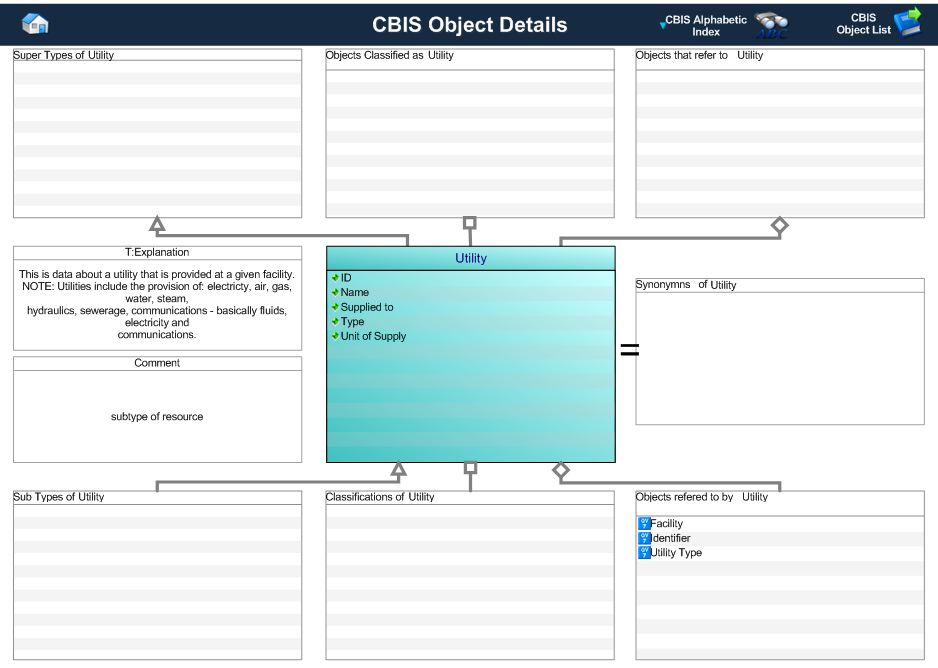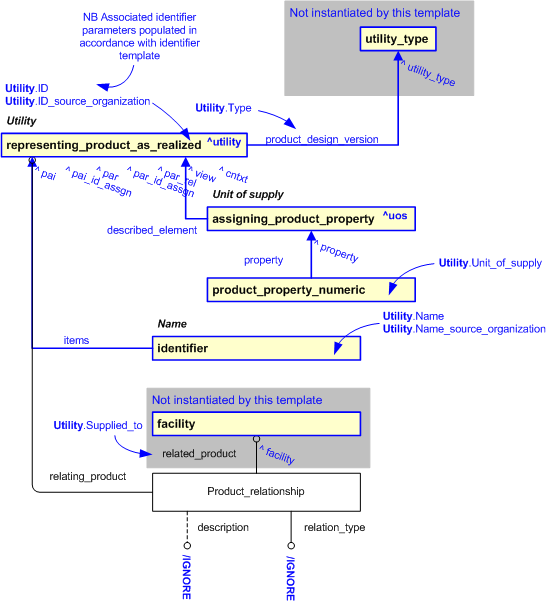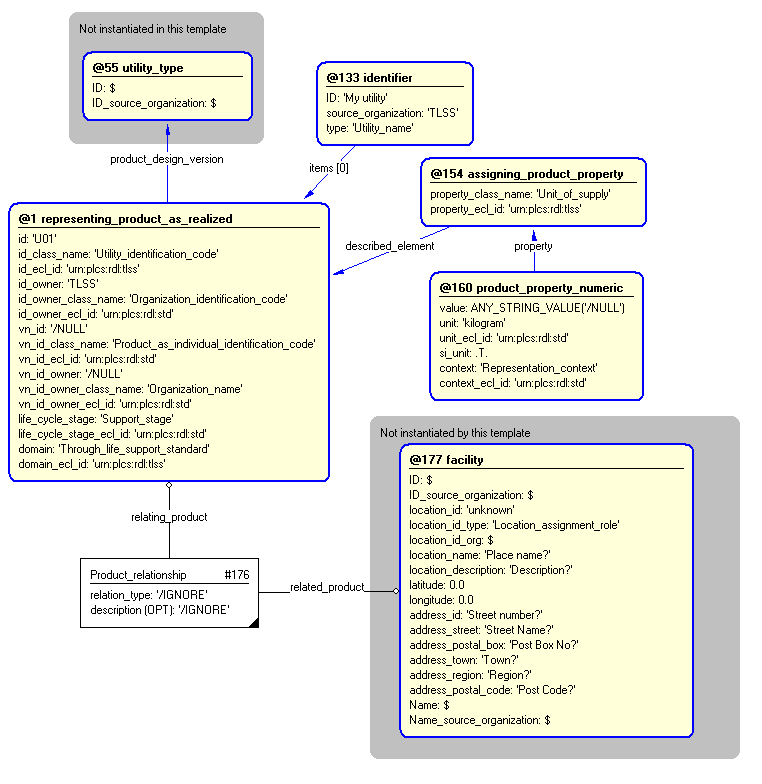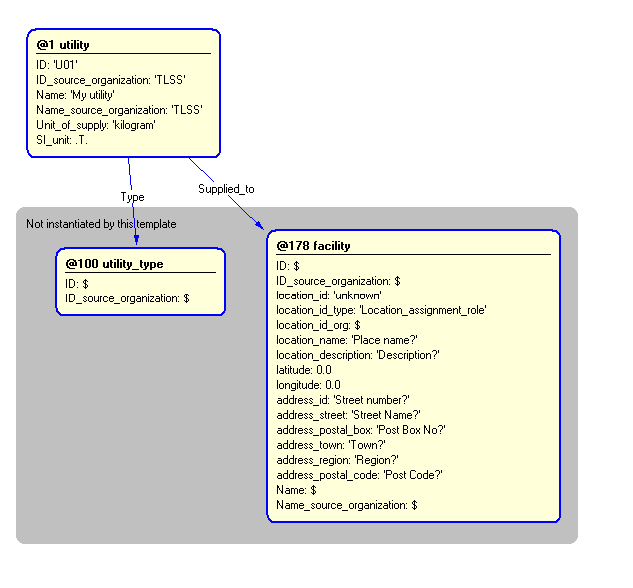Template:— utility (utl)
Context:— UK_Defence |
Date: 2009/04/17 12:40:21
Revision: 1.2
|
This section specifies the template utility.
NOTE
The template has been defined in the context of
UK_Defence.
Refer to the business context for details of related templates.
NOTE
An explanation of a template and the associated instantiation path is
provided in the
Template overview
section.
This template describes how to a represent a utility which may be referenced as a required resource for a task.
This is data about services that are provided at a given facility.
NOTE
Utilities include the provision of: electricity, air, gas, water, steam,
hydraulics, sewerage, electricity and
communications.
Figure 1 — Graphical Representation for Business Object Utility
Utility
The definition of a Utility object is:
Data about services that are provided at a given facility which may be referenced as a required resource for a task.
|
Attribute name
|
Attribute description
|
Attribute type
|
Optionality
|
| ID |
This is the identifier of the Utility. |
Identifier |
Mandatory |
| Name |
This is the name of the Utility. |
Intrinsic |
Mandatory |
| Supplied to |
This is the reference to the Facility to which the Utility is supplied. |
Facility |
Mandatory |
| Type |
This is the reference to the reference to the type of the Utility. |
Utility Type |
Mandatory |
| Unit of supply |
This is the unit in which the Utility is supplied.
EXAMPLE
Kilowatt hour, Litres
|
Intrinsic |
Mandatory |
Table 1 — Utility: attribute details
The EXPRESS-G diagram in
Figure
2
shows the templates and EXPRESS entities that are required
to represent the template
"utility".
The text highlighted in blue shows the template parameters.
Figure 2 — An EXPRESS-G representation of the Information model for utility
The graphic for the template to be used in other EXPRESS-G diagrams
is shown in Figure
3
below.
Figure 3 — The graphical representation of the utility template
The following input parameters are defined for this template:
The identifier of the organization responsible for the utility identifier.
The identifier of the organization responsible for the utility name.
The facility that the utility is supplied to.
The utility_type for this utility.
The class name of the unit in which the value is expressed.
The following classes and their sub-classes can be used:
Whether the unit of supply is an SI unit or not.
The following reference parameters are defined for this template:
Allow the
Product_as_individual
entity instantiated in this path to be referenced when this template is used.
%^target = $utility.utility%
Allow the
Assigned_property
entity instantiated in this path to be referenced when this template is used.
%^target = $utility.uos%
The following parameter combinations specify a uniqueness constraint:
Unique constraint: Unique Utility
The instantiation path shown below specifies the entities that are to be
instantiated by the template.
A description of templates and the syntax for the instantiation path is
provided in the
Templates Help/Information section.
-- Utility /
representing_product_as_realized(
id=@ID,
id_class_name='Utility_identification_code',
id_ecl_id='urn:plcs:rdl:uk_defence',
id_owner=@ID_source_organization,
id_owner_class_name='Organization_identification_code',
id_owner_ecl_id='urn:plcs:rdl:std',
vn_id=''/NULL',
vn_id_class_name='Product_as_individual_identification_code',
vn_id_ecl_id='urn:plcs:rdl:std',
vn_id_owner=''/NULL',
vn_id_owner_class_name='Organization_name',
vn_id_owner_ecl_id='urn:plcs:rdl:std',
life_cycle_stage='Support_stage',
life_cycle_stage_ecl_id='urn:plcs:rdl:std',
domain='Through_life_support_standard',
domain_ecl_id='urn:plcs:rdl:uk_defence',
product_design_version=@Type)/
%^utility = $representing_product_as_realized.pai%
/
identifier(
ID=@Name,
source_organization=@Name_source_organization,
type='Utility_name',
items=^utility)/
/
assigning_product_property(
property_class_name='Unit_of_supply',
property_ecl_id='urn:plcs:rdl:uk_defence',
described_element=^utility)/
%^uos = $assigning_product_property.property%
/
product_property_numeric(
value=/NULL,
unit=@Unit_of_supply,
unit_ecl_id='urn:plcs:rdl:std',
si_unit=@SI_unit,
context='Representation_context',
context_ecl_id='urn:plcs:rdl:std',
property=^uos)/
-- Instantiate a Product_relationship Product_relationship-- Set the Product_relationship attributes to be ignored Product_relationship.description = '/IGNORE'
Product_relationship.relation_type = '/IGNORE'
-- Set the Product_relationship relationships Product_relationship.relating_product ->
^utility
Product_relationship.related_product ->
@Supplied_to
The following entities are instantiated with attributes as specified:
The instance diagram in Figure
4
shows an example of the EXPRESS entities and templates that are instantiated by the template:
/utility(ID='U01', ID_source_organization='UK_Defence', Name='My utility', Name_source_organization='UK_Defence', Unit_of_supply='kilogram', SI_unit='True', Type='@100', Supplied_to='@178')/
(an illustration of the consolidated utility template is shown in
Figure
5 below.)
Figure 4 — Entities instantiated by utility template
The instance diagram in
Figure
5
shows the graphic symbol for the template that is to be
used in other instance diagrams. The example template is:
/utility(ID='U01', ID_source_organization='UK_Defence', Name='My utility', Name_source_organization='UK_Defence', Unit_of_supply='kilogram', SI_unit='True', Type='@100', Supplied_to='@178')/
Figure 5 — Instantiation of utility template
Characterizations
No common characterizations of the template
utility
have been identified. However, the ISO 10303-239 EXPRESS model
may enable other assignments to the entities instantiated by the template.




